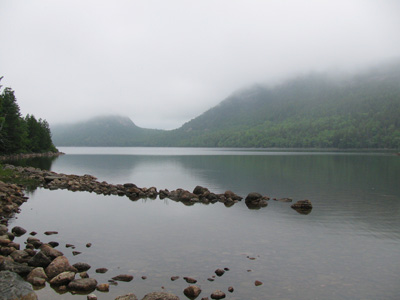Land of Fire and Ice
The Terror Tourist is my occasional segment on the Heavy Leather Horror Show, a weekly podcast about all things horror out of Salem, Massachusetts. These segments are also available as an email newsletter. Sign up here, if interested.
Greetings travelers! I hope you are prepared for an adventure — properly dressed in layers, extremities covered, feet shod in crampons — because we are going to Iceland. I’ve compiled an itinerary by watching every horror movie ever to come out of this small island nation. But before we take that excursion let’s pack our bags with some context.
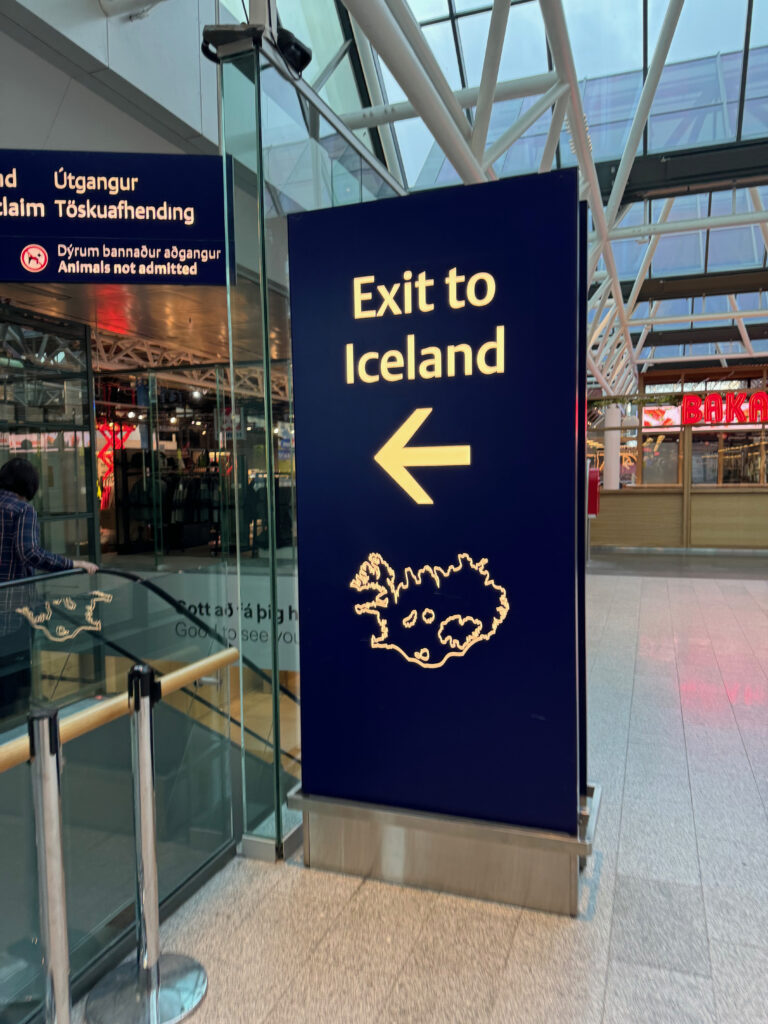
Iceland is Hawaii upside-down, a largely self-contained ecosystem in the middle of a vast sea perpetually remaking itself directly above a hotspot vent in the Earth’s mantle. Like Hawaii Iceland has been a prize of sea-going conquerors through history: the Vikings of course, but also the kings of Norway and Denmark, and even the occupying forces of Britain and the USA during World War II.
Both geologically and culturally Iceland straddles North America and Eurasia. In addition to being the morphing volcanic crown of the mid-Atlantic, Iceland exists right on the boundary of two tectonic plates, just kissing the southernmost boundary of the arctic circle, and slowly moving away from their one-time embrace. This position between two worlds enabled Icelander Leif Erikson to discover what would come to be called North America 500 years before Christopher Columbus — though Leif and his compatriots left behind only tool shards rather than genocidal European pathogens.
Icelanders know how to live between worlds. For example, some 35% of people in Iceland believe in elves. Called Huldufólk, these “hidden people” appear human but live in a parallel world overlaid on our own, popping in and out of our reality at will. How can you tell them from us? It’s subtle. Huldufólk have a convex rather than concave philtrum below their noses. So, yes, I spent much of my recent trip to Iceland staring intently at people’s upper lips. Awkward and uncomfortable for all parties involved, but this is my responsibility as the director of this terror travel agency.
Iceland hosts all kinds of supernatural creatures, most of which you will find in their amazing literary legacy known as the sagas. Part history, part genealogy, part mythology, these tales are unique to Iceland and date to the 9th through early 11th centuries. If interested look up Snorri Sturluson, Iceland’s revered national poet and historian. Actually just say his name — Snorri Sturluson — and feel a smile come to your face.
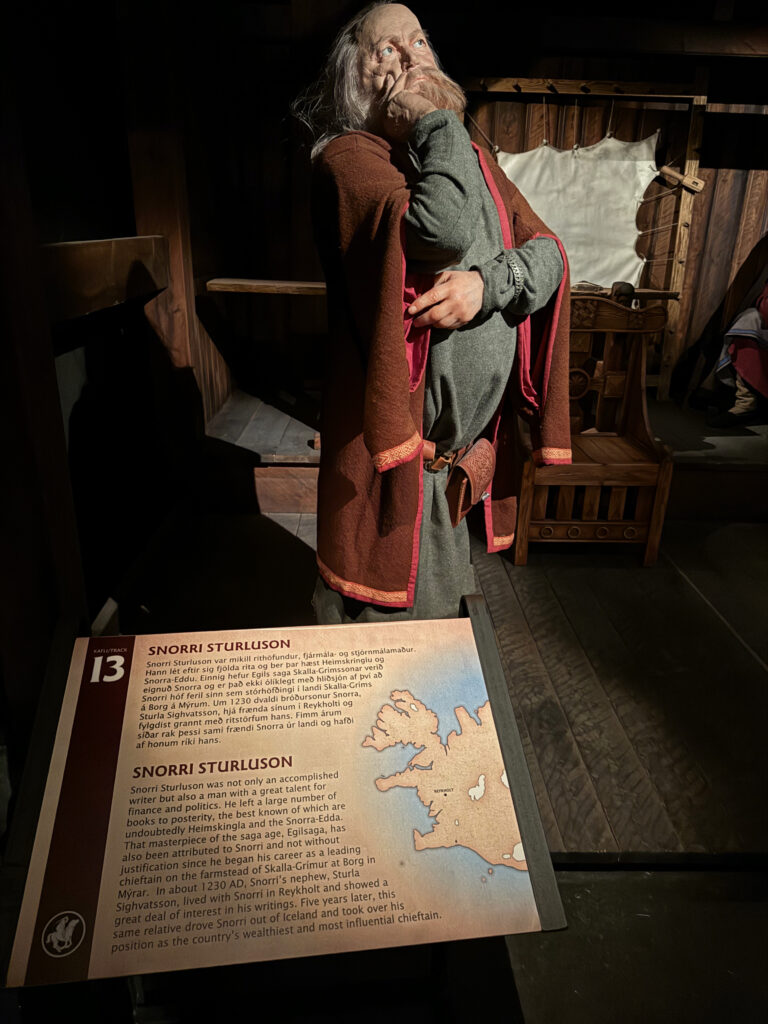
The sagas feature draugr what we’d call “ghosts”, the aptrganga literally “again-walkers”, the haugbúi literally “mound-dwellers” as well as trolls, giants, witches, sorcerers, and devils. All of these nightmares fall into the category of reimleikar or “hauntings”. Interestingly what often gets translated as “ghosts” in Iceland are actually corporeal. These things have physical bodies and can do physical harm. There’s also the legend of the Útburður — literally the “out-carried”, babies left outside to die of exposure — unwanted because of rape, incest, or conception out of wedlock who return as ghosts. That one kinda messed me up.
So you pause here with me on our journey, travelers, and ask the obvious question: Are all the scary things in Iceland fantastical? Aren’t there any humans to be feared? The answer is: not really. Iceland is consistently ranked the #1 safest country in the world. (The USA comes in a 131 out of 163.) And there is honest-to-Odin only a single known serial killer in all of Icelandic history. In the late 16th century a farmer named Axlar-Björn was convicted of killing 9 people, mostly boarders and farmhands, variously by axing them to death or drowning them. He likely killed more than 9 as a search of his farmlands yielded many more bodies. Ol’ Axlar was executed for these crimes by first having his limbs shattered with a sledgehammer, then his privates severed and tossed to his pregnant wife, then he was beheaded and dismembered — each severed body piece receiving its own display on a stake. His children weren’t much better people, frankly. Years later the last words of his son who was being executed for robbery and murder were “If I were free I would kill you all and eat your flesh.”
But honestly other than that particular family, there isn’t much to be afraid of in Iceland … except Iceland itself. That is, literally, the ice and the land.
Let’s start with the darkness. Like all places as far north (or south) as Iceland much of the year is very dark. The sun barely peeks above the horizon in the winter. It’s a gloomy vibe, not quite pitch, but certainly unsettling — like a permanent eclipse. As a sidenote, this seasonal darkness may explain why Iceland and Finland have the highest percentage of metal bands per capita in the world. And not just Viking metal. This is perhaps obvious if you have ever tried to pronounce an Icelandic word as basically every other term in an Icelandic dictionary would make a great black metal band name. And Iceland officially does not allow foreign terms in its language. So when a new concept emerges, like the computer did in the 1940s they make one up. In this example, they joined the term for number (tala) and witch-doctor or prophetess (völva) A computer is thus a number witch-doctor and the new word is … Tölva. Which is my last name. I am, unfortunately, 0% Icelandic.
But let’s get back on the path. Iceland is called the land of fire and ice and that’s no marketing slogan. Well, actually it is, but it is for truth. There are more than 30 active volcanos ripping their own scabs from the land. At any given time quite a few of these are actively spewing lava or scalding mud and ash. In fact, when I was there a few weeks ago we witnessed a crater field which had been dormant for a few months fissure and begin erupting right before our eyes. Icelanders live with this peril, indeed embrace it as the source of many good things, but not incautiously so.
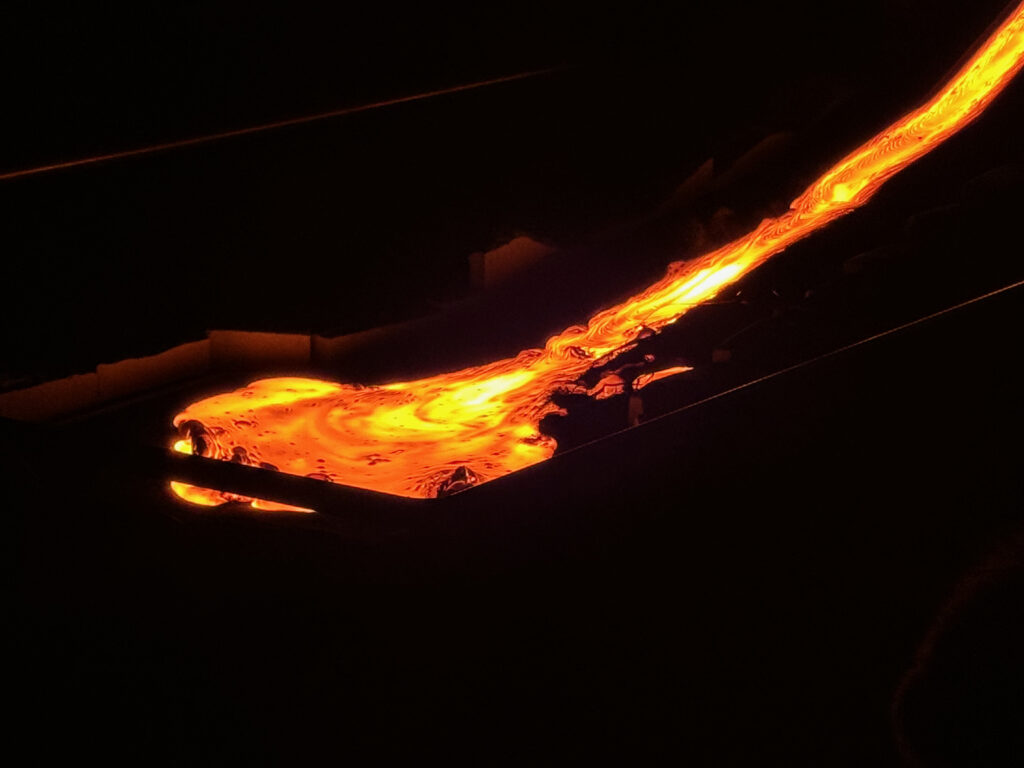
In fact what worries Icelanders more than volcanos is what sits on top of them, which is usually glaciers. We all know that our planet’s glaciers are melting at a worrying rate, but detonate a geothermal bomb underneath them and, well, they melt really quickly. In an eruption all that molten rock and ash mixed with millions of cubic acres of now-melted ice cap hastily seeking lower ground will ruin your day right quick. And Iceland’s biggest city Reykjavik sits on one of the most volcanically active peninsulas of the entire island. Iceland would not exist without vulcanism and one day, hopefully later rather than sooner, it will likely cease to exist because of vulcanism.
Then there’s the sea itself. The North Atlantic is an angry place. Got an unsinkable ocean liner? It’ll take care of that. The waters are rough, rogue waves are commonplace, the whole thing is plied by an unruly fleet of icebergs constantly calving off from increasingly-unstable glaciers, and the water, naturally, is freezing. Typically if you find yourself bobbing in said water you will live as many minutes as the number of degrees celsius the water is above freezing. So let’s say you were lucky enough to spill over into a warm patch of ocean, say 5°C/40°F, you’d live for approximately 5 minutes. As a darkly humorous aside, there is a huge culture of swimming pools (indoor obviously) in Iceland. This is a legacy of a realization in the early 20th century than an above-average number of sailors were drowning due to incidents just offshore that otherwise would have been close enough to swim to safety. Thus Iceland made it mandatory — which it is to this day — to be able to swim. It’s part of childhood educational curriculum. I pause to wonder why the people of a nation literally surrounded by the ocean, criss-crossed by waterfalls, and in a constant state of glacial melt sogginess wouldn’t have previously thought knowing how to swim was important, but who am I to say?
One last way that Iceland wants to kill you. All the aforementioned geological instability produces a lot of earthquakes. No need to delve into that particular kind of calamity except to note that Iceland is one of the only places on earth where there is a non-zero chance of being crushed by tectonic plates underwater. The Silfra Fissure in beautiful Thingvellir National Park is a glacial lake that straddles the cleft made as the North American and Eurasian continental plates slowly move apart. It’s a popular snorkeling and diving site where you can touch both plates at once. And if there’s an earthquake while you’re down there, welp, that’d be a pretty great way to go, no? Reclaimed by earth itself. And yes, it was cold in that drink: 35°F. If not for our drysuits my son and I would have spent our last 1.5 minutes together.
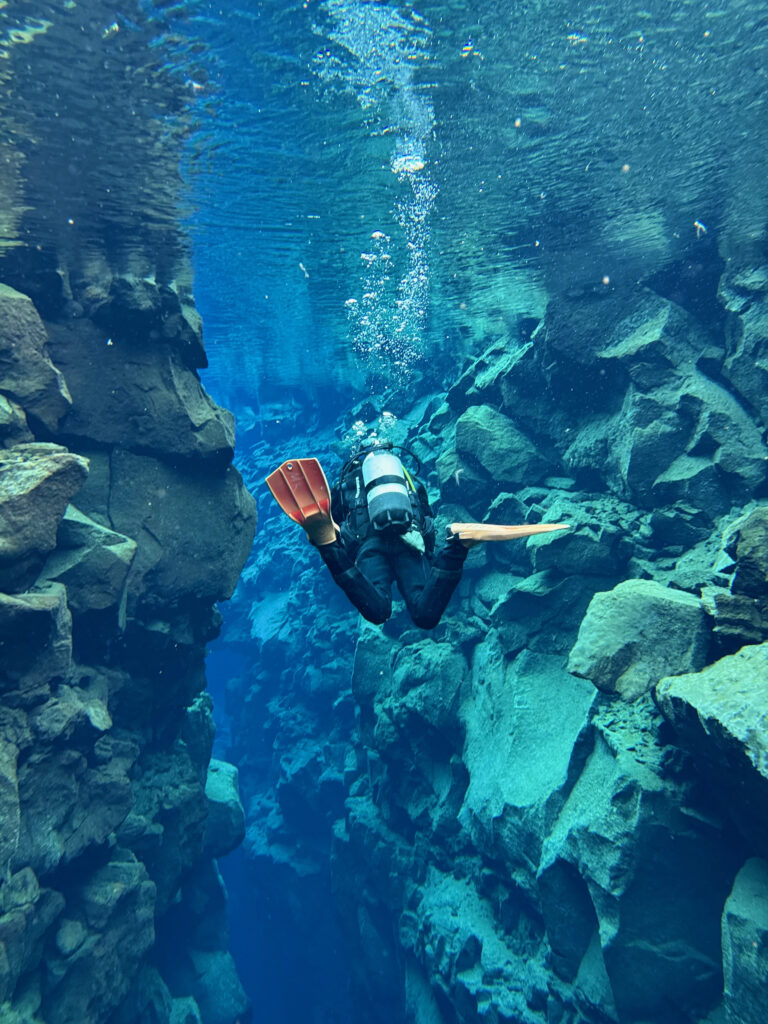
OK let’s catch our breath on this hike. In and out. In and out. We’re warm, we’re dry, nothing is erupting on us, let’s move on … to horror movies.
Here’s the thing. Given the landscape, Iceland seems like the perfect place for the horror imagination to run wild. Match a hostile environment with centuries of ghost storytelling tradition and the fact that it’s exceedingly easy to become isolated in such an unpopulated place. But honestly horror just isn’t a huge genre in Icelandic cinema. This may simply be due to size. Iceland just doesn’t produce as many movies as, say, the much larger, much more populous countries of Sweden or Norway.
But this is an opportunity for our itinerary, my weary travel buddies! It occurred to me that I might be able to watch the entire output of a single country’s horror film industry. And that’s exactly what I attempted to do over the last few months. Did I succeed? Well … I watched 11 films, but there are a few festival-only shorts, made-for-TV specials that were never rebroadcast or put online, and at least one film which does not exist with any subtitles or dubbing. So, no, I did not see everything. But I saw almost everything and certainly the best things.
First a note on Jóhann Jóhannsson, the peerless Icelandic composer. (His albums Englabörn, IBM 1401, and Fordlandia will change your conception of what classical music can do.) For our purposes though it should be noted that Jóhann wrote the music for the 2018 revenge bloodbath Mandy. It was his final work prior to dying of heart failure at the age of 48. If you’ve seen Mandy you know how crazy its score is. Panos Cosmatos, Mandy’s director, said of Jóhann “[he] went above and beyond, and I suspect to the limits of his sanity, to make the music for this movie.” Growing up surrounded by Iceland’s black metal music scene and having seen and loved Cosmatos’ previous film Beyond the Black Rainbow, Jóhannsson reportedly pled his case for the job saying “Holy shit, you guys are making something … that is in this nightmarish, psychedelic metal world that I was born and bred on”. Cosmatos hired him and said “I basically wanted it to feel a little bit like a disintegrated rock opera, and Jóhann responded to that. We developed a kind of shorthand almost immediately.” The movie was made, Jóhann died tragically, and now Cosmatos says he cannot bring himself to revisit the soundtrack. “I’m almost afraid to listen to it in isolation, because I still have emotional strands attached to it.” Have a rewatch — or more specifically a re-listen — of Mandy if you want to get a real flavor of Icelandic horror genius.
These 11 films are representative both of the thematic diversity of Icelandic horror and in various ways are uniquely Icelandic. Here we go!
Reykjavik Whale Watching Massacre (aka Harpoon, 2019)
This splatter shlock features a cameo from Iceland’s most famous — perhaps only legitimate — horror movie celebrity: Gunnar Hansen. That’s right: Leatherface. (Gunnar’s family moved to the USA when he was 5-years-old and the rest is history.) In this movie I learned that there are good reasons Leatherface was non-verbal in the original film only some of which have to do with the story itself. Hansen is just not a good actor. The plot finds a group of tourists stranded on a malfunctioning whale-watching boat who are picked up by a bunch of homicidal whalers running what amounts to a floating torture chamber. The whole thing is weirdly xenophobic with lots of uncomfortable stereotypes about the different nations of the tourists. There are some decent kills, including with harpoons, but this movie goes on for a least one act too many. It was already overly-long when it occurred to me that I, the viewer, had not seen a single whale. Fear not: stock footage to the rescue! There is indeed one kill from an orca. If this were shot on film you could probably see where this scene was stapled onto the existing celluloid reel.
Tilbury (1987)
This made-for-TV movie is classic WTF-did-I-just-watch? Based on the folk belief in a tame imp called a Tilbury which would suck milk from other people’s cows, return to its owner (almost always a woman), and then disgorge butter for her. When not stealing milk for re-processing the Tilbury feeds from a nipple inside its owner’s thigh. Oh and these imps are brought to life using communion wine served between its owner’s breasts. With that all as preface, it’s no surprise that this the visuals in this movie are vile. The story follows a modern day Tilbury conscripted into the British occupying forces during WWII.
Thirst (2019)
Billed as “MOST BAD-ASS GAY VAMPIRE ZOMBIE SPLATTER MOVIE YOU’LL EVER SEE…EVER”. Not four minutes into this film — which I’ll note that I watched on an airplane — we get screaming, gory vampire fellatio. This is so not a movie to watch on an airplane, certainly not with strangers next to you. It basically follows an elderly vampire who kills by ripping his victims’ penises off. Clearly this is done for comedic effect. At one point he even eats a penis in a hot dog bun. Not surprising when you consider that a top ten tourist attraction in Reykjavik is the Iceland Phallological Museum — a gallery of preserved penises and penis ephemera from various species. Thirst itself is a decent film and super gory, particularly a scene when a person is ripped in half top to bottom with the vampire’s bare hands in the snow. It’s part detective story, part commentary on Christian cults. But mostly it’s just goofy fun.
Lamb (2021)
Maybe the best movie I watched on this journey. It’s quintessential folk horror and apparently the highest grossing Icelandic film (of any genre) to date. Featuring Noomi Rapace who you may have first seen in Prometheus. Set on a farm in rural Iceland the style is ultra-realistic, beautiful and minimal, with no soundtrack. Noomi and her husband nurse an ill, hybrid newborn lamb to health, keeping it indoors, nursing it with a bottle, swaddling it to sleep in a bassinet. Hybrid you say? Yeah, it’s half human, but not like a centaur, just some of its limbs. It is bipedal though which is disturbing enough having a toddler with a lamb head running around the house. The lamb’s mother keeps showing up looking for it. Noomi has grown attached to her new “baby” so she kills and buries the mother lamb. This turns out to be a very bad idea. An excellent movie, but don’t expect to leave this movie with a warm fuzzy feeling.
Graves & Bones (2016)
This film is partially a response to the financial crisis of 2008 which hit Iceland abnormally hard — three banks failed, the largest economic trauma to any country relative to size. It opens with a little girl, Perla, stopping the swaying of someone we later find out was her father who has hanged himself. Gunnar is awaiting the decision on his appeal of a conviction for financial fraud — it was Gunnar’s brother, also connected to the fraud, who hanged himself, Perla his daughter. Gunnar and his wife head to a country house to assume responsibility for their now-orphaned niece. It’s a ghost house, of course, but more than that this is a movie about a marriage falling apart over grief — and an external financial crisis — which manifests in horrific ways. The juxtaposition of martial strife bordering on combat and elements of the supernatural are surprisingly effective and affective — it was tough to watch. Eventually you learn the backstory of the house and it all crescendos into a satisfying if bleak climax.
It Hatched (2016)
Another story of a childless couple in rural Iceland who unexpectedly get a baby, as in Lamb, which turns out poorly for everyone involved. Two isn’t a trend, but I’m still trying to figure out if there’s something deeper going on. In It Hatched, a couple moves from Nashville to a place way out in the middle of nowhere in Iceland. Turns out there’s a pit to hell in their basement from which emerges a ghost-devil who impregnates the lady of the house. She eventually gives birth to an actual egg, which of course hatches a seemingly normal baby, at least at first. This film has real promise with setting and premise, but the acting is odd and suffers from pacing issues. Scrambled, you could say.
Bokeh (2017)
Remember The Langoliers by Stephen King, a short story turned mini-series about a guy who wakes up from a nap on a flight and 90% of his fellow passengers are gone? That’s Bokeh, except it’s American tourists, Jenai and Riley, in Iceland who wake up one morning (after watching the northern lights the night before … in the summer, somehow) and there isn’t a soul left around. It’s a great conceit in any context, made especially so set in Iceland whose landscapes seem to exist without relation to (or care for) human agency. The couple experiences the various stages of apocalyptic realization: confusion, panic, welcoming the rapture, acceptance that there is no rapture, hey wait! laws/social norms/money no longer matter — let’s party! You could excerpt parts of this movie as a tourism promotion as these two just wander around beautiful landscapes and the unpeopled streets of Reykjavik.
But eventually it all falls apart. The couple frets about how they will ever get off the island. The geothermal grid starts to fail, water stops flowing. They bicker over the proper order in which to eat expiring food. It’s a dark psychological drama underwritten by a low-grade end-of-the-world vibe. But it’s also in part a morality tale about living in the moment. Eventually our Adam and Eve meet the anti-Job, a guy who is still somehow still alive living in a cabin and determined to give up. He teaches them the Welsh word hera: grief for a home to which you cannot return. I’m not sure there’s anything specifically Icelandic about this emotion, but Iceland certainly makes for a great setting for its exposition.
⅓ of the entire cast of Bokeh is Maika Monroe who made her debut in It Follows. Reddit of course links the two films: “This movie is a sequel to It Follows and the main character, played by the same actor, had sex with someone and then they had sex with someone (and so forth) until everyone died/disappeared. The old man was the last person to go before it was Jenai’s turn. The reason Riley survived was because he never had sex with her as he was waiting for marriage. (Obviously).” And now I want to dream up other unintended sequels linked by mutual actors.
Child Eater (2016)
If you thought the incessant repetition of “This ends now!” and “Evil never dies!” from Halloween Kills was cringey, boy have I got a movie for you. I debated including this one, as it is set (and shot) in the Catskill Mountains of the USA, but its writer and director, Erlingur Thoroddsen, is from Iceland. Child Eater ultimately is part cabin-in-the-woods, part stalker babysitter, with a dash of Jeepers Creepers and A Nightmare on Elm Street — which you might otherwise think was an homage, but this is really just a mess. You see, there’s a gnarled old guy living out in the woods, abducting children, and then eating their eyes in an effort to keep himself from going blind. That’s it. That’s the movie.
Rift (2017)
Not to be confused with The Rift (reviewed on the previous Terror Tourist), this ambitious story of two former lovers centers on the sexual and emotional trauma that characterized their relationship. Amazingly this thoughtful, beautiful, haunting film comes from the same writer-director as Child Eater, Erlingur Thoroddsen — and only a year later. The guy’s got range is what I’m saying. Like most of the other films here, Rift uses the tension between the sublime and the outright terrifying of Iceland’s landscapes metaphorically. Mind the rifts wherever they appear. This film may be too slow for some viewer’s tastes and those who desire firm closure might be disappointed. But it’s worth it just for the two leads’ performances. Maybe make it a double feature with Child Eater just to test the limits of your cinematic taste?
I Remember You (2017)
Probably the most ambitious film in the mix, I Remember You is two intertwined stories, one a mystery of a child lost in the city (naturally Reykjavik), the other a more straightforward tale of haunting at a remote seaside cabin. Some of the fun of it is simply trying to figure out why these two strands are being told in the same filmic container. Your effort will be rewarded in the end, thankfully. Keep your ears open for the wonderful sound design and your eyes peeled for the Exorcist III hospital corridor call-back. Óskar Thór Axelsson, director and co-writer, knows what he’s doing.
Spell (2018)
Here’s Iceland through an American tourist lens. A man, Benny, escapes to the island after the tragic drowning death of his fiancee. Their difficult relationship comes through in flashes throughout the film as a backstory. There are several interesting things about Benny. He has a compulsion to lick things, like surfaces and rocks — pica, sorta — which is only mildly disgusting until he visits the (very real) Icelandic Phallological Museum when it becomes farcically disgusting. Benny is also an unfulfilled illustrator. This matters as a plot point when he meets some Icelanders that want to show him off-the-beaten path sites. Benny’s runic scribblings apparently convince his creepy tour guide that he’s “chosen” (for what we’re not entirely sure). Spell is a movie about grief, dumb Americans in Europe, mourning, mental illness, and superstition. There’s something comfortable about the rhythm of this film. The beat seems to be building to a compelling climax. But the drum kit falls off the riser in the end — which is a shame since the other 90% of this film is very entertaining.
I suppose what I learned on this journey through a small genre from a small island is that Iceland very much does its own thing stylistically. Certainly there are homages and influences from other countries’ film traditions, but every one of the films we just visited have elements that are unique to Iceland’s traditions, location, or circumstances. And the country continues to produce. Recently The Damned, a 19th century shipwreck period fright,premiered at Tribeca. Iceland even has its own, singular horror festival called Frostbiter this year from Nov. 15-16. So if you’re in the area, check that out!
Thank you for traveling with me today. Until our next excursion, may your itineraries be horrific and fulfilling!
A full list of the movies mentioned above can be found at Letterboxd. Find out where to watch there.
Occultation in Texas
My son and I intercepted the total solar eclipse on April 8. It was even more remarkable — larger, darker, spookier — than the only other we’ve seen in Wyoming in 2017.

We were relatively unprepared for the one seven years ago (eye protection, yes; ways to capture the experience, not really). But since then — and with the help of an annular eclipse dry run last October — we were ready this time. We knew we wanted to be as near the centerline as possible but with the ability to call a cloud cover audible if needed.
On the morning of the eclipse we headed south from Fort Worth, Texas to a small town called Hillsboro (excuse me, Eclipseboro) but upon arrival determined the clouds were too risky. So we motored northwest, giving up about a minute of totality for what we hoped were clearer skies. Destination: Glen Rose. We found a public park on a branch of the Paluxy River right in town and set up shop.
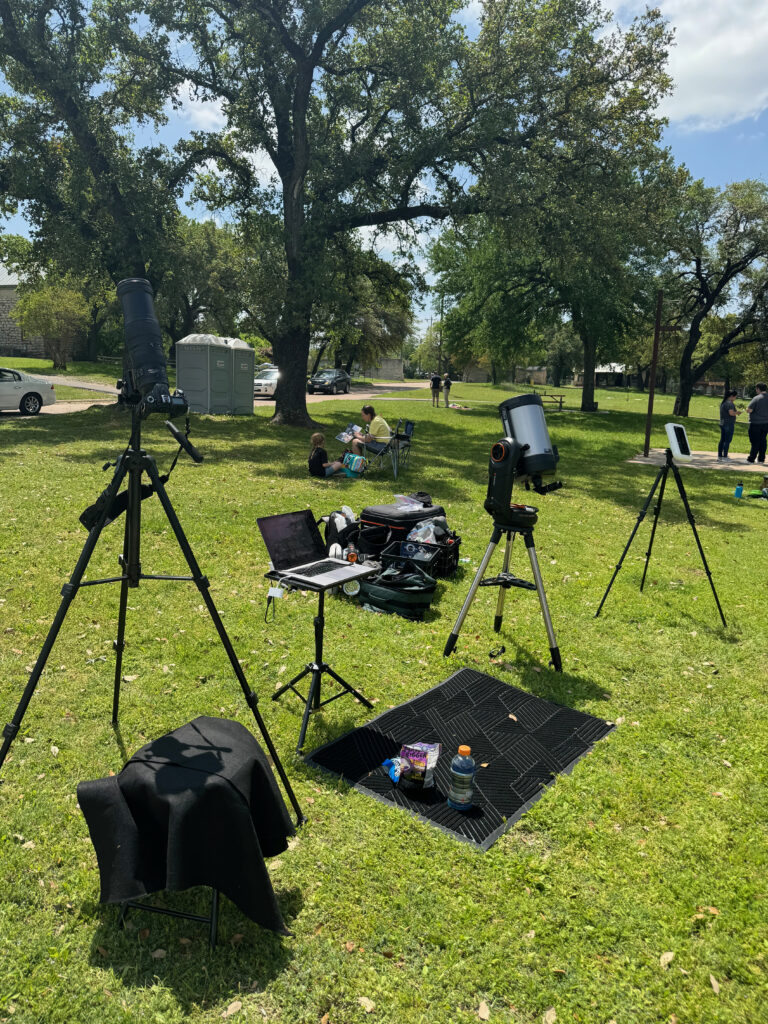
We had three viewing rigs:
- Nikon D90 dSLR + Nikkor zoom lens (AF-S 200-500mm f/5.6E ED VR) + Haida solar filter. This was controlled via USB connected to a MacBook running AstroDSLR, mostly to relieve the tedium and distraction of snapping lots of photos during totality but also to avoid slightly jiggling the rig with a button press on the camera body.
- Celestron NexStar Evolution 8″ telescope + solar filter. I never did turn tracking on as the sun was fairly easy to spot. I probably should have enabled it though. (Next time!)
- The new Vaonis Hestia mount for iPhone. This small white box held the phone in place over its magnifying ocular (with solar filter) allowing photography and on-device processing in real time. I used an iPhone 15 Pro Max. It captured remarkably good photos, such as the composite above.
Having done this a few times by this point I was looking forward to the mix of normal people just out to have their minds blown (often with small children) and giant astronomy nerds ready to shout “first contact!” and similar at every moment of the event. I suppose there are other types of people who show up for eclipses — astrology zealots, doomsday cultists, daytime-curious vampires — though none did where we watched unfortunately.
The moments approaching totality were especially surreal as the day, which normally darkens from a fixed point on the western horizon, got shimmeringly dark from everywhere at once. Light through leaves and colander holes reminded us that our celestial flashlight was no longer circular. We peered through obsidian glass (supposedly used by ancient Mayans to view eclipses, which they accurately predicted). While the obsidian monocle seemed just as dark/protective as our ISO-certified glasses in hindsight maybe I should have verified that.
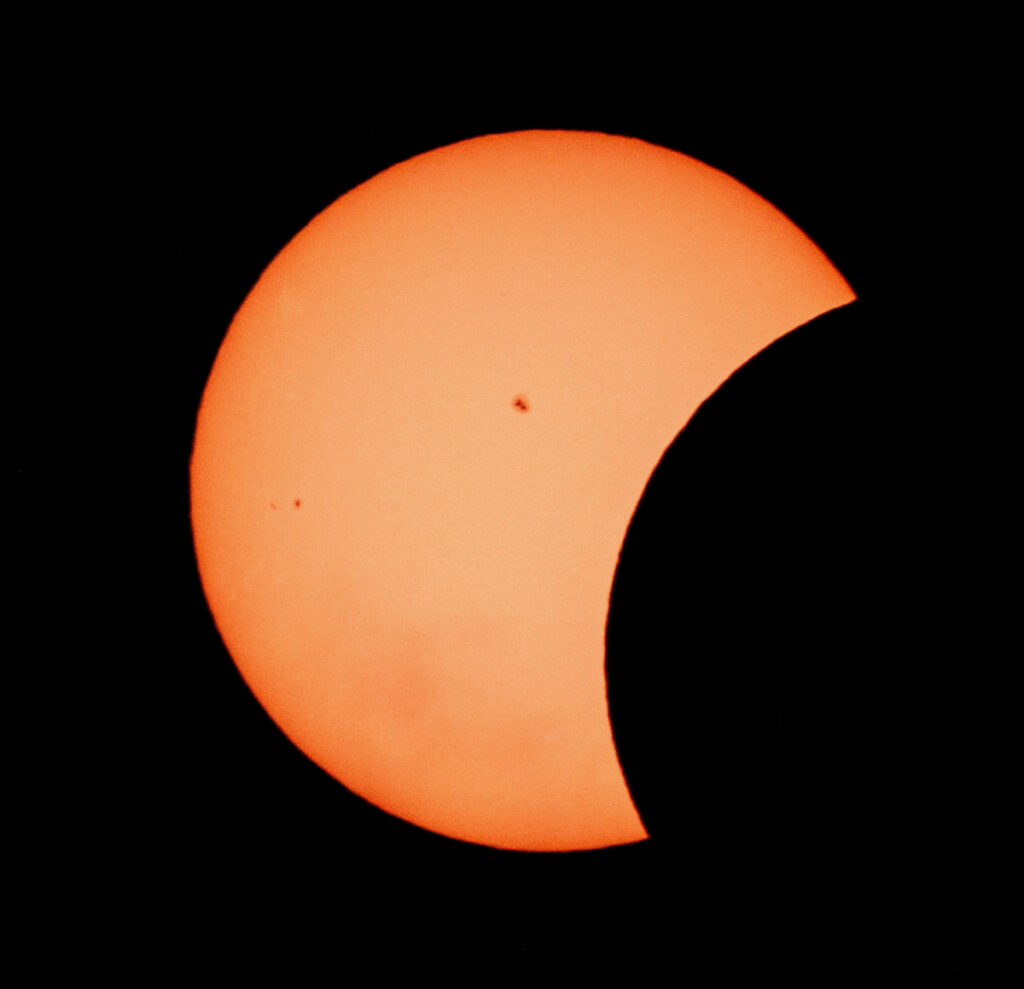
And then it went dark and the protective eyewear finally came off. I’m sure I could look it up to confirm or deny, but it felt like the sun-moon duo was closer in space to us than in 2017 because that scary black hole in the sky looked much bigger. Loopy prominences licked around the edge of the disc while we stared up slack-jawed for both the longest and shortest three minutes and fifteen seconds of our earthbound existence. I couldn’t help but think about how terrifying it all would have seemed for pre-scientific peoples viewing a total solar eclipse. A few minutes of inexplicable darkness and then … right back to normal. (A Navajo friend of mine noted that his people do not view the eclipse as a matter of respect. Tradition holds that it is a time of intimacy between the sun and the moon. Voyeurism is impolite.)
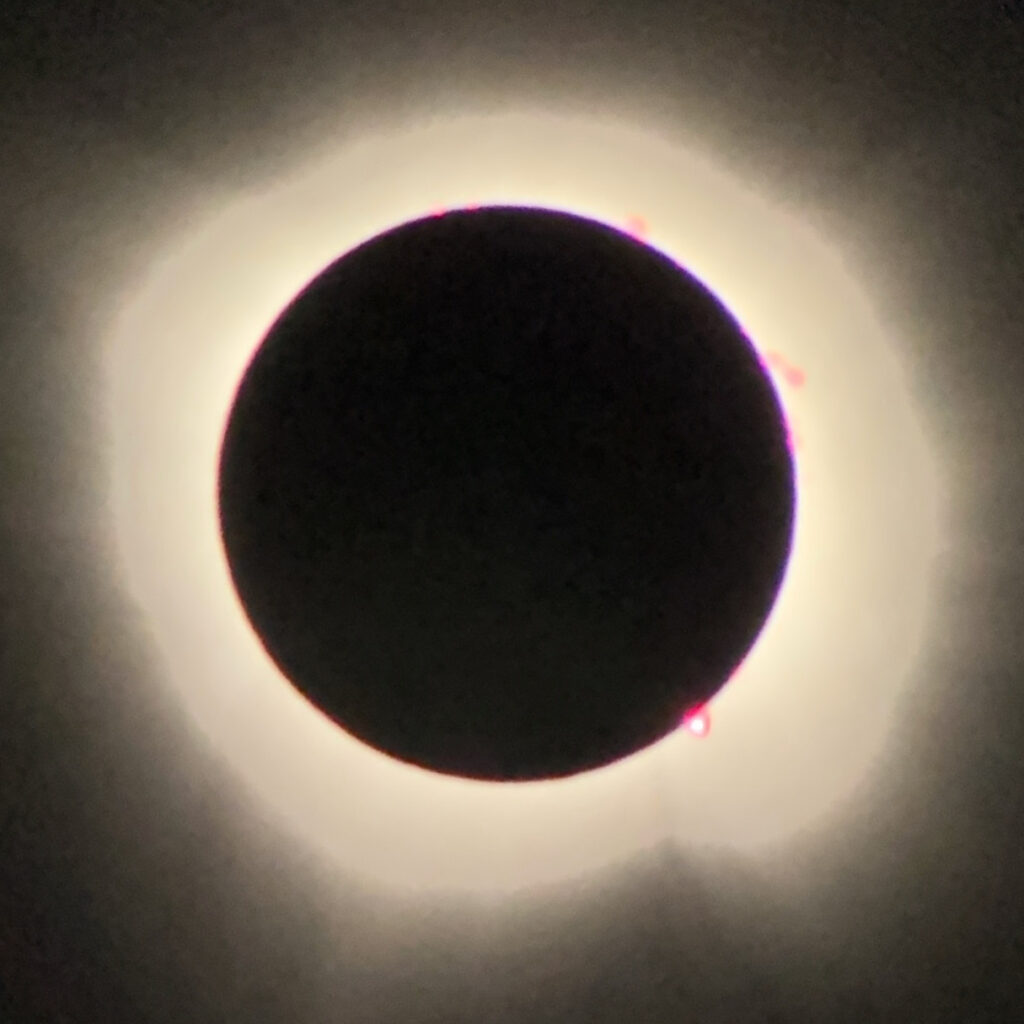
While we were dumbstruck in Texas (and as my other son was preparing for the umbra hurtling away from us and towards him in Vermont at 2,000 MPH) my wife was on an airplane over Ohio. She noticed little crescent-shaped sparkles on the cabin wall next to her window seat. This disco ball effect was caused by reflections from the partially-eclipsed sun glinting off her wedding ring! As my wife was the only person in her section who brought eclipse glasses, she eventually had the whole cabin at her seat staring at our moon nudging in front of our star.
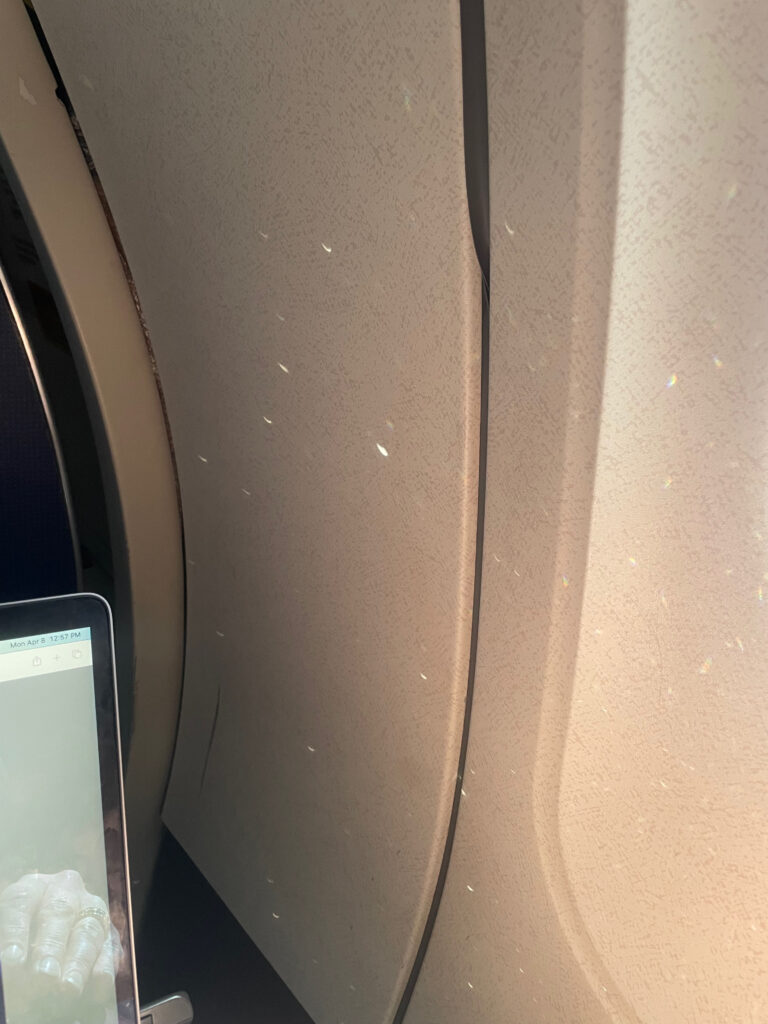
On the drive down from Denver I learned quite by chance that helium is so named because its presence was spectroscopically determined during an 1868 eclipse in India. The chance part of my learning this was due to my stopping at the Helium Time Columns Monument time capsule in Amarillo, Texas — former site of our nation’s strategic helium reserve. Even though helium is the second most abundant element in the universe, those dirigibles and zeppelins weren’t gonna inflate (or blow up) themselves. So America stockpiled.
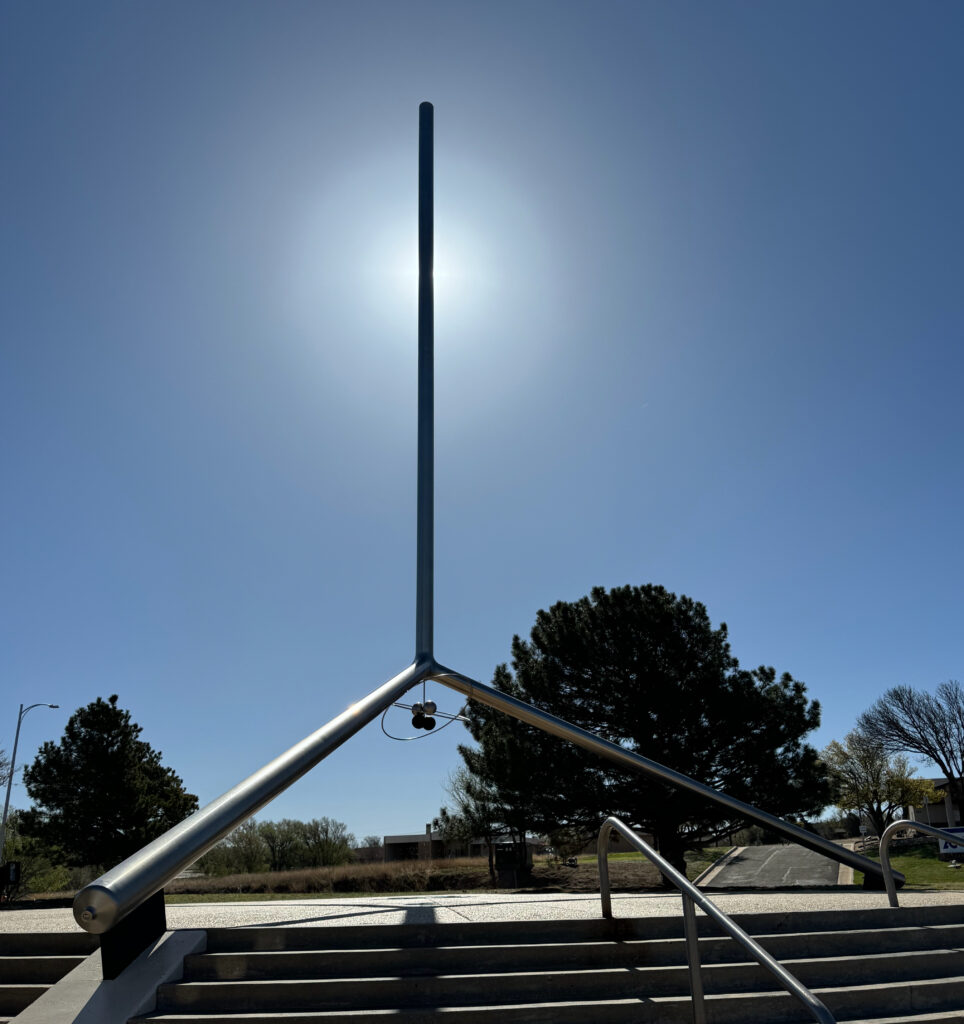
But back to Glen Rose. Other than being in the crosshairs of totality, this pretty little town is the jumping off point for two related points of extreme cognitive dissonance.
The Paluxy River flows right through town and into Dinosaur Valley State Park, where over the last millions of years it has eroded various types of rock to expose Early Cretaceous dinosaur tracks of both sauropods and theropods. The fun thing about these trace fossils is that they exist almost exclusively in the flowing riverbed itself. You gotta wade if you wanna nerd up. Often because of high water the tracks are not visible at all. But on my visit they were on full display. It was rainy and wet (obviously) which gave the expedition a slight air of danger but the park is well-signposted and easily accessible. Plus, with water continuing to erode the riverbed, this priceless evidence of dinosaur behavior is slowly being erased. Catch them while you can. (Or go see this entire section that was lifted out and sent to the American Museum of Natural History in NYC.)
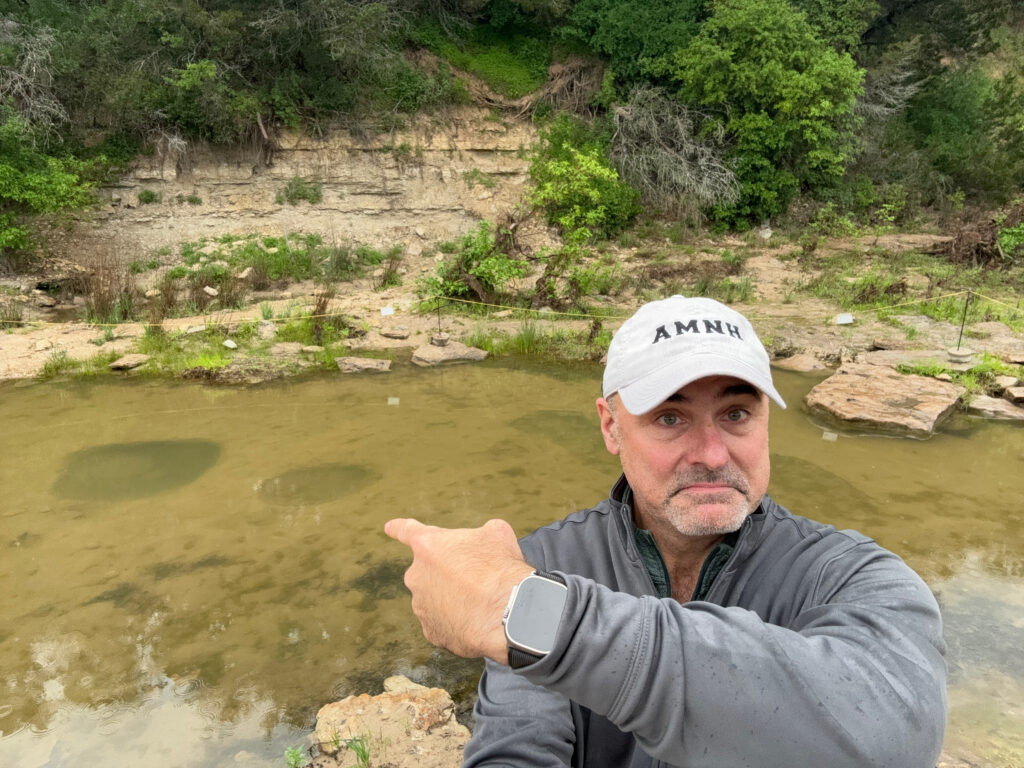
But scientific artifacts are not the only thing this river has gurgled up. Glen Rose is also home to the Creation Evidence Museum where tracks lifted from the Paluxy are purported to prove that humans lived side-by-side with dinosaurs, Flintstones-style, which of course thus proves biblical creationism, an earth only 6000 years old, and other utter fictions. The contortions this museum wriggles itself into to prove that the fossil record synchs with the bible are comical: mapping geological epochs to precise days of biblical flood, building a model of an ark complete with holding zones for Tyrannosaurus rex (seems unwise, Noah), and a giant hyperbaric chamber meant to recreate conditions for bringing non-avian dinosaurs back to life. What.
The centerpiece of the museum are tracks that show impressions of human footprints next to or overlaid on dinosaur tracks. Most of the footprints are deliberate fakes created to sell during the Great Depression but the urge to validate an already-held belief can be powerful and sometimes you build an entire fantasyland around that. Of course, there’s margin for error in all paleontological and geological time estimates but being off by 100 million years is, you know, well outside that margin. We actually find evidence of ancient peoples next to dinosaur tracks all the time. They were as fascinated by fossils as modern humans are, but that doesn’t mean that humans rode Velociraptors bare-back.
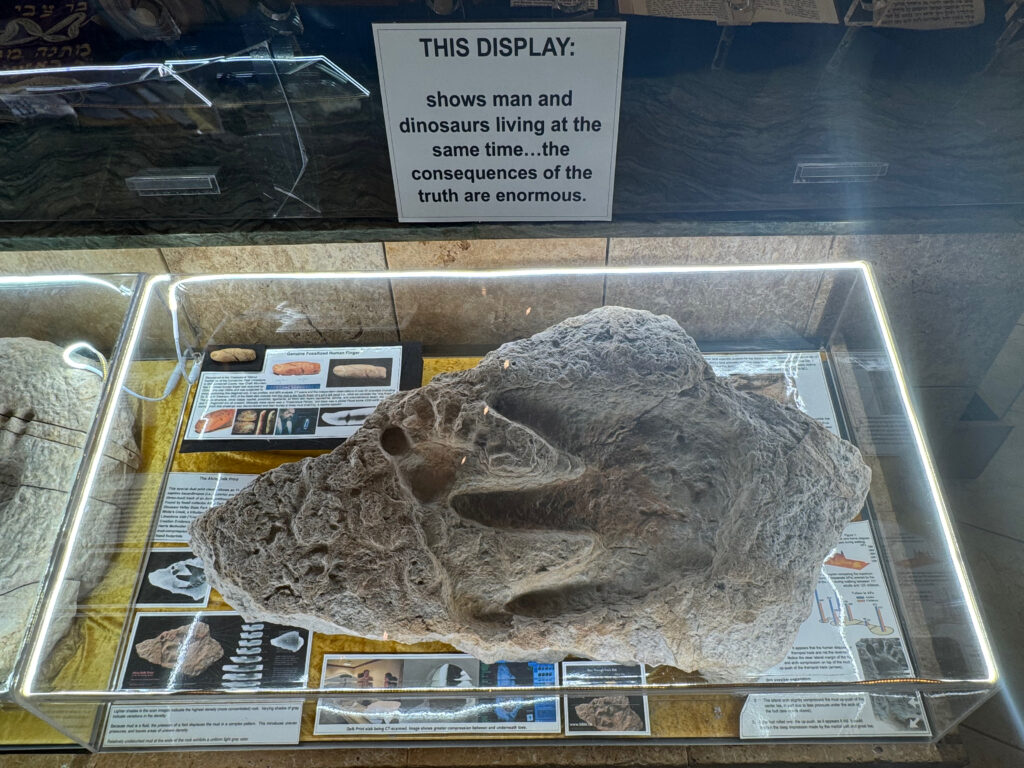
It was difficult to maintain a straight face in this place, I admit. The cartoonishly white-coated and goggled “scientists” running around a lab full of seemingly legit equipment (what exactly were they testing?); the bus full of home-schooled kids, grist for the generational conspiracy theorist pipeline; the non sequitur side exhibit on the moon landing (presented as real, not a conspiracy — possibly meant to allay fears that the curators are complete crackpots). An entire universe of fallacy meant to make people feel good about not questioning their faith.
We don’t still believe eclipses are a dragon eating the sun, or celestial gods at war, or even a moment of intimacy (the Navajo offer this respect out of cultural tradition). Science advances because we constantly question it. It’s how we discover helium. It’s how we verify Einstein’s General Theory of Relativity. It’s how we know exactly where to stand in a beautiful little town in Texas to view a rare astronomical event. So, thank you, science. And thank you Creation Evidence Museum, for the concise if troubling example of what happens when you want to be comfortable in belief rather than disquieted by truth. Go see the next total solar eclipse, friends. (Or better yet, go see the 2027 eclipse over the pyramids of Egypt!).
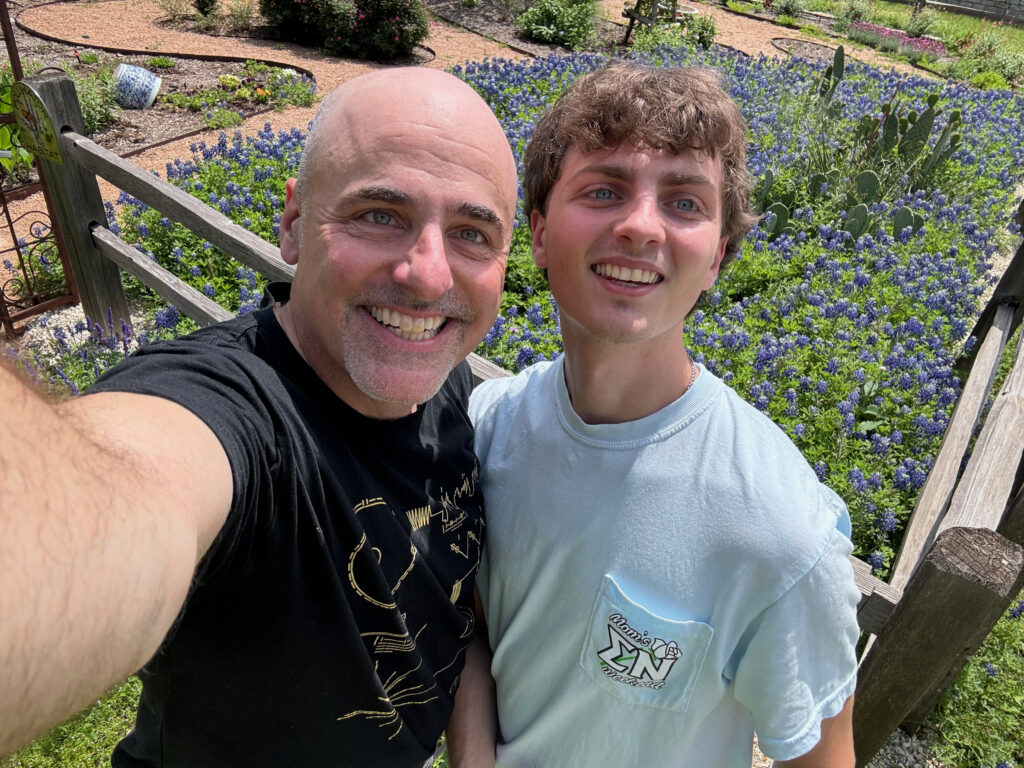
Itinerary footnote: this journey included a few other stops related to dinosaurs and crazy right-wingers: An easy hike to the KT boundary in Trinidad Lake State Park (lots of shocked quartz layers from the meteor impact that ended the reign of the dinosaurs 66 million years ago); the excellent dinosaur trackways of Clayton Lake State Park in New Mexico, where tracks became visible when a reservoir spillway was constructed decades ago; and Bishop Castle, the monomaniacal building project of a father-son duo in rural Colorado that is what happens when someone really loves the garden gnome aesthetic and spatial logic of M.C. Escher while also hating workplace safety and all forms of government.
Negril, Jamaica
May 2012. Eight couples of college friends all turning 40 this year, a 16th wedding anniversary, rum, reefs, and a commemorative mix of reggae and its descendants, below.
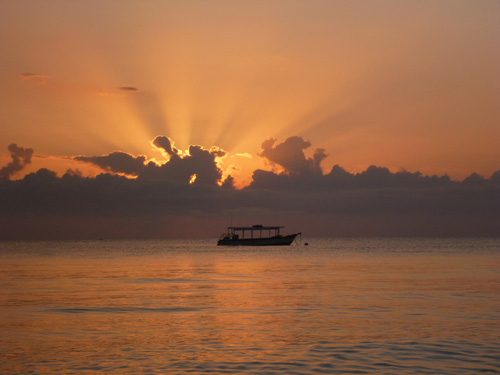
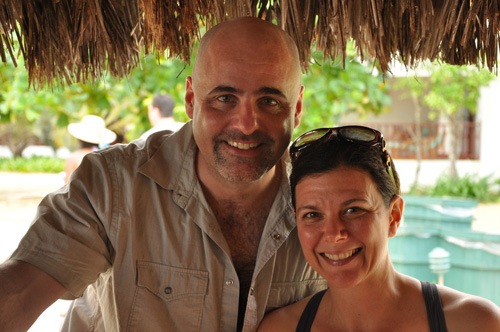

We kept the spirit alive with a dinner party this weekend after returning home. Jamaican theme, of course.
- Shellfish watermelon ceviche (with scallops and shrimp, photo below)
- Jerk vegetables (summer squash, zucchini and mushrooms) and chicken skewers
- Red snapper in coconut curry broth
- Coconut lime rice
- Avocado, orange and goat cheese salad
- Appleton rum cake
- Mango sorbet
- Rum cream over ice

Full photo set here.
Upcomings
Spring’s nowhere near Chicago right now, but the seasonal onslaught of conferences seems not to heed nature’s cycles. I’m going to be in a bunch of places coming up. Would love to meet up if you will be near.
Transportation Camp East
New York, NY
March 5-6
South by Southwest Interactive (+ new day after Technology Summit)
“Smarter Cities: Driving Sustainable Growth”
Austin, TX
March 12 – 16
APA National Planning Conference
“Technology Infrastructure and Planning”
Boston, MA
April 11-12
RPA Regional Assembly
“Smart Cities, Smart Citizens”
New York, NY
April 15
National Mayor’s Summit on City Design
“Design and 21st Century Challenges”
Chicago, IL
April 27-29
Urban Systems Symposium
“Defining Urban Systems”
New York, NY
May 11-12
Full travel schedule here, for those interested. (There’s a good chance I will be in DC a bunch too.)
Oh, the places I’ll be
Leaves are turning, weather’s chilling, Keynote’s revving. Time to hit the road for the fall circuit of conferences, talks, and meeting folks. It’s going to be a crazy slide to the end of the year with two projects launching amidst all this.
Personal Democracy Forum – Europe
Barcelona, Spain
4th-5th October 2010
#pdfeu
City Camp London
London, United Kingdom
8th-10th October 2010
#ccldn
IBM Place Summit
Cambridge MA
Oct. 16-19
Open Cities 2010
Washington, United States
4th-5th November 2010
Full travel schedule here. There’s also a great new social site for tracking conference attendance at Lanyrd.
Confabulism
New year, new conferences. And some old favorites too. Here’s a list of places I’ll be speaking in the next few months. If you’ll be at any of them, let me know. Would be great to meet up.
City Camp
January 23-24
Chicago, IL
ORD Camp
January 29-30
Chicago, IL
South by Southwest Interactive
March 13-16
Austin, TX
Panel: The City Is A Platform
IA Summit
April 9-11
Phoenix, AZ
Talk: Metropolitan Information Architecture: The future of UX, Databases and the (Information) Architecture of complex, urban environments — god, who writes that?
I’m sure more will pop up in the first half of the year. You can always follow my public Dopplr profile to see where I’ll be.
Hello, travel!
By southwest
Last year’s travel almost sent me to an early grave and I’m earnestly trying to scale back this year. But there are some destinations I can’t bring myself to skip. Like South by Southwest.
I’m particularly excited about this year’s event, mostly because the panelists on the talk I’ll be moderating are so damn interesting.
- Irene Au, Director of User Experience, Google
- Chris Bernard, User Experience Evangelist, Microsoft
- Moshe Tamssot, Vice President, New Services, Kraft Foods
- John Wolpert, Executive Director, Team UpStart
Here’s the official panel description:
Entrepreneurship in the Belly of the Beast
Small is beautiful at SXSW. From Getting Real to starting up, the ethos is largely anti-large corporation. This attitude overlooks one of the most satisfying professional accomplishments: doing your own thing while working for The Man. This presentation uses examples to offer strategies for making the corporation work for you.
And the unofficial addendum: this panel at one time had a subtitle that seems to have gotten lopped off: “Why Working For a Gigantic Company Isn’t As Bad As SXSW Would Have You Believe”. The idea basically is to explore the dominant SXSW sensibility that large organizations are somehow inimical to creativity and innovation.
The idea for organizing something like this had been percolating for a while, but was pretty much solidified with this back-and-forth from last year’s SXSW.
The talk is scheduled for Monday, March 16, 11:30am – 12:30pm.
If you’re attending SXSW, stop by and say hello!
Sightings
Some upcoming talks for those of you who like your rambling in person.
Tomorrow I’m attending the Chicago Colloquium on Digital Humanities and Computer Science at the University of Chicago. It is a small, single-track, free (!) conference that I have wanted to attend for years. I’ll be in the poster sessions, fishing for interest in using our non-profit grid for scholarship in arts and culture.
On Nov. 7 I’ll be speaking at the University of South Carolina in Columbia. The talk is called “Architecting Cultural Spaces: The Past, Present, and Many Futures of Digital Humanities” as they kick off their own Center for study of the same. I’ll post to Slideshare when it is complete.
I’ve had a panel accepted for next year’s SXSW festival. It’s called Entrepreneurship in the Belly of the Beast — basically an anti-SXSW screed about the opportunities for getting away with stuff in a big company. I’ll most likely be booed off stage by startup junkies. Or fired for calling my company the Beast. Win-win.
If you’ll be at any of these events in the coming days and months, please drop a line!
Maine holiday
Just back from a first-ever trip to the coast of Maine. What an amazing place.
Couple of tips for the uninitiated. You’ll encounter lots of puns on the name “Maine”: Maine-ly Antiques, Maine Drag, The Maine Attraction. Avoid these at all costs. Also, an easy clue as to how greedily a place wants your tourist dollars is to note the amount of signage and text that spell things according to the Maine accent. If you see more than one reference to “lobstah, chowdah, and beeya” leave. Immediately. Lastly, if you hate the Red Sox do not visit Maine.
To boil down what Maine thinks it has to offer I present you with the following list:
- lobster
- blueberries
- moose
- the way life should be
- a carbonated beverage called Moxie
- lighthouses
- puns on the state name
But it is really so much more than that. Have a look.
Hailing a ride in Russia
To an American it seems nuts, but when you think about it it makes perfect sense. In St. Petersburg to get a ride you step into the street and wave at any damn car that comes by. Taxi or not, some cars will stop, you negotiate the cost, and on you go.
My first thought about this, years ago, was: that’s freaking nuts. Who knows who will pick you up. Urban hitchhiking. Cabs for Communists.
But it really is convenient. All a matter of density, really. Think of automobiles moving about the city not as individually-owned but simply as transport from A to B. Chances are good that someone is going somewhere near where you need to be. You’re not hailing a ride to the sticks, most likely. And if the person is not going exactly where you are they (or you) either decline or you get closer to your destination. Let me tell you, for 80% of the year in St. Petersburg this is preferable to slogging through the Arctic bluster.
It’s the ultimate Zipcar, Asimov’s sidewalks on Trantor, and France’s failed Aramis transport all in one. And relatively green too. Perhaps the only environmentally-friendly thing in St. P.
I like.













